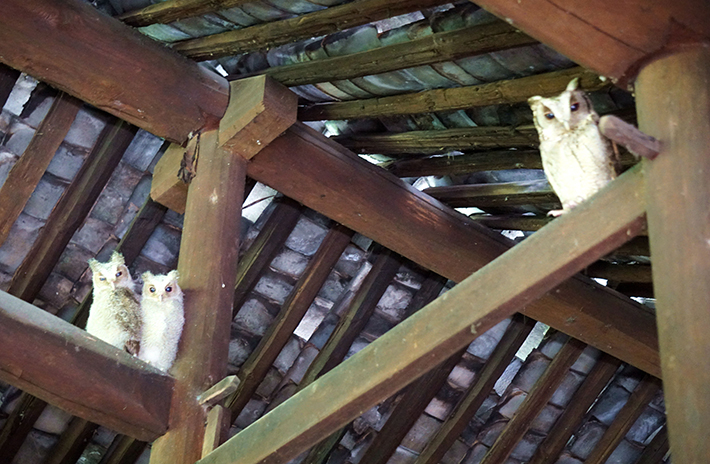|
||||||||||
| Home Nation World Business Opinion Lifestyle ChinAfrica Multimedia Columnists Documents Special Reports |
|
||||||||||
| Home Nation World Business Opinion Lifestyle ChinAfrica Multimedia Columnists Documents Special Reports |
| ChinAfrica |
| Weaving Wildlife Protection |
| Villagers flock together to protect feathered friends |
| By CUI XIAOQIN | VOL. 15 December 2023 ·2023-12-21 |

A view of the Songyin Creek Wetland in Songyang County, Lishui City, Zhejiang Province
On 6 August, Zhou Guimei, a villager from Huangnan Village, Dadongba Town, Songyang County, Lishui City in east China’s Zhejiang Province, found a “strange bird” she had never seen before while washing clothes by a stream. She said the bird had green claws, big eyes, a sharp beak and white spots on its wings. She noticed that it couldn’t stand up, so she assumed it had been injured. Zhou immediately contacted the village ranger and took the bird home. While waiting for the ranger, she tried to feed the bird a bite of fish, but it quickly spat it out.
Ye Weirong is the deputy secretary of the Communist Party of China (CPC) Huangnan Village Branch, as well as the village ranger. He immediately reported the news to the forestry authority of Songyang County, took pictures of the bird and sent them to the forest patrol group on Weixin, one of China’s most popular instant messaging apps. Forestry officials rushed to Huangnan Village that night and took the bird to a wildlife hospital for medical treatment. Experts identified the bird as the White-Eared Night Heron, an endangered species under national protection. The results of the examination showed that the bird had not sustained any injuries, but that its stomach contained many parasites, rendering it unable to eat or stand up. A few days later, after careful treatment, the fully recovered bird was released back into the wild.

Every year at the end of February, owls arrive at Yuan Linwei’s old house in Huangnan Village, Songyang County, Lishui City, Zhejiang Province
Passing the baton
With an estimated population of only 1,000, the White-Eared Night Heron is one of the 30 most endangered birds in the world. They live mainly in valleys with dense forests and high hills, and in places with special water quality and environment. Ye was very happy to see the appearance of the night heron because it means that Songyang’s ecological environment has improved significantly.
It is a tradition in Songyang for everyone to love birds and wildlife. A prime example is Yuan Linwei’s family, who have been protecting owls for several generations.
“It was 1989 and I was only 9 years old. While playing in front of my house, I found an owl chick in an open field.” Yuan recalled how he and his grandfather took the chick back to the nest. Since then, every year by the end of February, a pair of owls would appear at Yuan’s house and fly away four months later with three or four chicks. Yuan is now over 40 and for the past 30 years, his family has lived in this old yellow mud house. They have not moved or renovated, just making sure that generations of owl “tenants” can lay their eggs, hatch and brood in the attic of the house. So far, more than 100 owls have been born in Yuan’s home and then returned to nature. He later learned that the owl was a Collared Scops Owl, or Otus Lettia, and that it is a species under national second-class protection.
Songyang’s improved ecological environment has attracted more and more wild animals to settle down in the area. As of 2010, every winter, the scaly-sided merganser would fly to Songyang to spend the winter there. Songyang has become a real “bird paradise.” In May this year, around the International Biodiversity Day, Songyang organised the fourth International Invitational Competition for Birdwatching of Lishui City. Thirty competing teams from China and abroad recorded 228 species of birds in two days, setting a new record for the competition, compared with 133,165 and 195 species in the first, second and third editions, respectively.
“For many, birdwatching has become more than a hobby. Observing and recording birds, and even carrying out educational campaign on human’s feathered friends have become the responsibility of those who care about nature,” said Xie Wei, president of Lishui City Bird Ecological Protection Association.

Zhou Guimei, a resident in Huangnan Village, Songyang County, Lishui City, Zhejiang Province, recalls her finding of a White-Eared Night Heron, an endangered bird species under national protection
Joint effort
It is the extensive public participation that has made Songyang’s ecological story go viral online. The owls living in Yuan’s house have now become celebrities in their own right. In May 2020, Lishui City Radio and Television Station’s account on Douyin, Chinese version of TikTok, livestreamed the owl stars 24/7, with hundreds of thousands of netizens eagerly tuning in to watch the mother raise her chicks.
The owl videos have been viewed more than 300 million times. Many netizens said they would watch what the owls were doing before going to work in the morning, and again at night after coming home from work. Chai Songwei is an engineer with the Songyang County Natural Resources and Planning Bureau. One late night, his phone was ringing off the hook with countless calls claiming the owl had gotten stuck in the attic exit. Chai quickly contacted Yuan to investigate. It turned out that the owl had caught a large rat stuck in the attic vent, and the many worried fans were relieved when the crisis was over.
In December 2022, during the second phase of the 15th Conference of the Parties to the Convention on Biological Diversity in Montreal, Canada, Yuan’s owl story touched everyone when it was told during the Zhejiang Theme Day at the event’s China Corner.
“In Songyang, protecting wildlife has become the local consensus,” Zhou Dongmei, secretary of the CPC Huangnan Village Branch, told China Today, adding that the local radio station introduces wildlife protection-related concepts and knowledge every day, lifting villagers’ awareness of wildlife conservation. There are also a number of signs along the road reminding tourists to protect wild animals.
Protection guaranteed
The current protection mechanism is essential for Songyang’s rich wildlife resources. In recent years, the local government has continued to explore feasible measures to protect wildlife. Ye told China Today that villages in Songyang each have two forest rangers responsible for regular patrols and anti-poaching, and there is also a “forest chief” to ensure the protection of endangered wildlife species.
In the first half of this year, the Songyang County Natural Resources and Planning Bureau installed four dome cameras at the main activity sites of the scaly-sided merganser’s wintering habitat, and purchased and installed 13 infrared wildlife monitors at suitable locations. At the same time, it is deploying staff with data collectors to patrol the routes as needed to assist wildlife in need of assistance. In the first half of this year, patrol mileage reached 121.9 km and more than 13,000 birds in 22 species were monitored, with no wildlife anomalies found.
| About Us | Contact Us | Advertise with Us | Subscribe |
| Copyright Beijing Review All rights reserved 京ICP备08005356号-5 京公网安备110102005860号 |